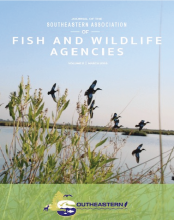Northern Watersnake Selection of Fish Prey in Western Kentucky
Watersnakes serve a variety of important roles in aquatic ecosystems with many species being of conservation interest. The northern water- snake (Nerodia sipedon) has some populations of concern, but is found in a wide variety of aquatic habitats throughout North America. Although previous studies have examined the diet of this typically piscivorous species, research has not addressed whether the northern watersnake is preferentially selecting particular fish as prey. In this study, we sampled snake stomach contents and used Chesson's alpha selection index (αi) to investigate whether...
